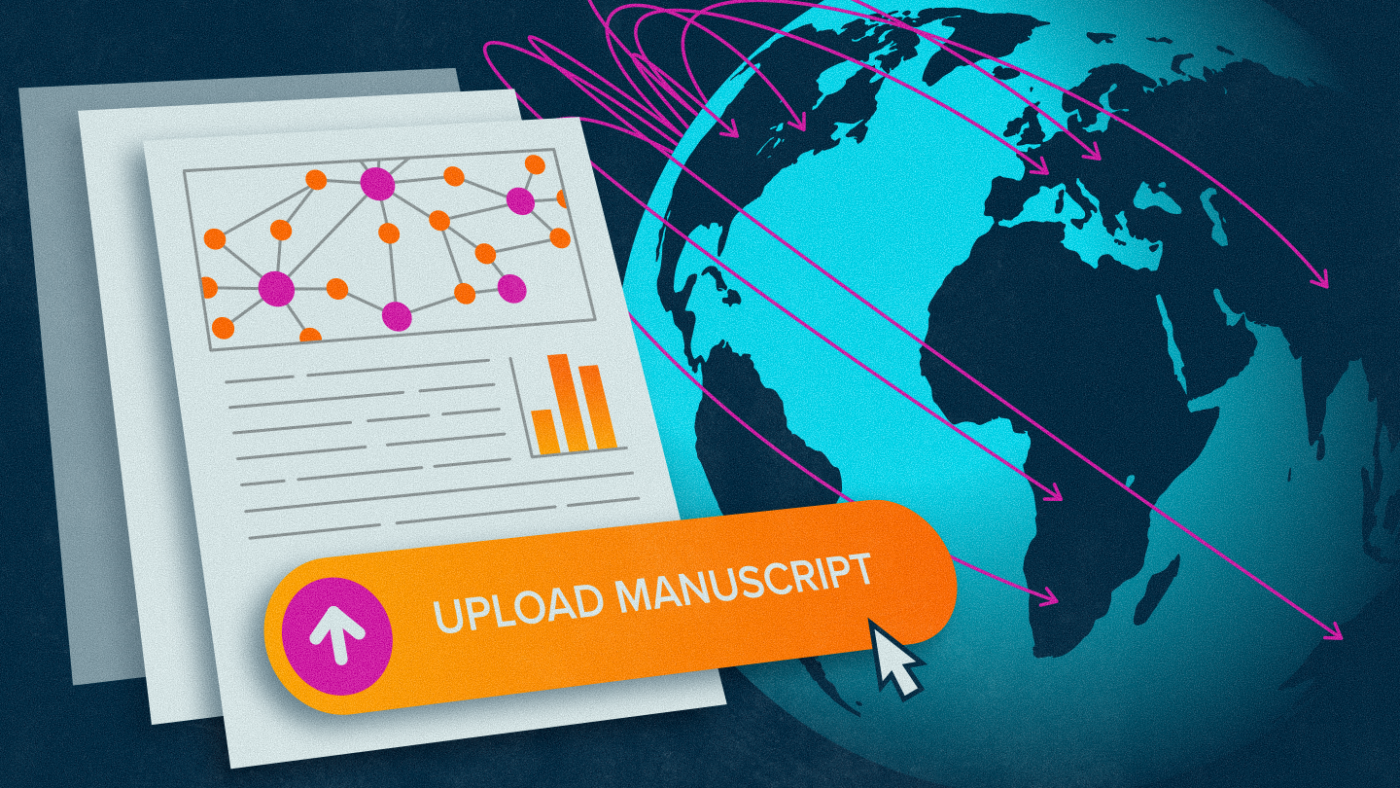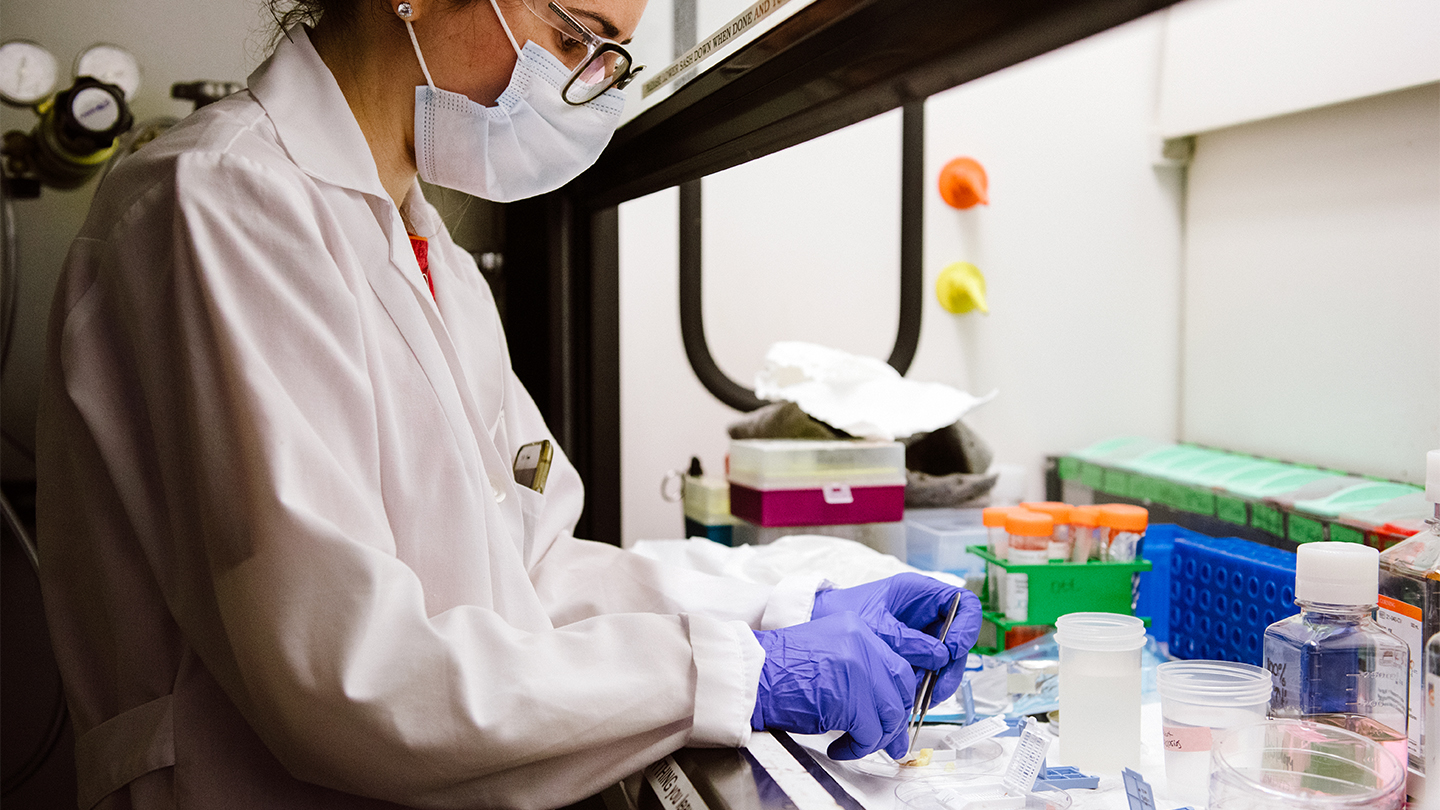Gladstone NOW: The Campaign Join Us on the Journey✕

Gladstone investigators are using the preprint server bioRxiv to advance their research and get information out more quickly.
When the COVID-19 pandemic was shutting down much of the world during the spring of 2020, a team of researchers led by Gladstone Institutes molecular biologist Nevan Krogan, PhD, was hunting for tools to battle the disease.
Specialists in understanding how genes and proteins interact to govern cell functions, Krogan’s team became the first to clone 26 of the 29 genes of SARS-CoV-2, the virus that causes COVID-19. That allowed the researchers to quickly map protein interactions that could reveal potential targets for new drugs—and point to existing drugs that might be effective against the virus.
The investigators realized that what they had learned could help accelerate the work of researchers worldwide who were shifting their focus to the new virus. The findings of such research are usually detailed in academic papers submitted for publication in scientific journals, where they undergo a months-long process of peer review, editing, and revisions before the information becomes available to the research community and the public.
Krogan quickly submitted a paper to the journal Nature, which fast-tracked it for publication in little more than a month, record time even for COVID-19 papers whose processing has been accelerated during the pandemic.
However, Krogan wanted to get the paper out to the research community immediately, so he also posted it on bioRxiv, a repository for unpublished preprints where scientists can freely read and comment on new reports. Specializing in biology research, the bioRxiv server is among more than 60 discipline-specific platforms created to help reduce the time needed to distribute critical scientific information.
In addition to the bioRxiv posting, Krogan’s team announced the findings on their Twitter feed, provided information for an article in The New York Times—and even offered to share the materials necessary for other scientists to study the protein interactions.
In a matter of weeks, Krogan had shared the materials with more than 450 labs in at least 40 different countries.
“I got hundreds of emails from people thanking me and telling me about the research they had done based on these findings,” says Krogan, a senior investigator at Gladstone and director of the Quantitative Bioscience Institute at UC San Francisco. “This could not have worked out better.”
More than 30,000 COVID-19 related scientific articles were hosted on preprint servers within 10 months of the first confirmed case.
Despite this success, Krogan remains concerned about routinely short-circuiting the peer-review process, which is designed to ensure the accuracy of published research results. Examples of errors and misinterpretation in papers distributed on bioRxiv and other preprint servers convinced him to be cautious.
“There are clearly pluses and minuses,” he says of bioRxiv. “In the context of a pandemic, we need to get good information out to people quickly. I think we are still learning when we should use this and when we shouldn’t.”
While the practice of placing papers on preprint servers ahead of peer review remains controversial in the scientific community worldwide, others at Gladstone have, like Krogan, found it a positive experience.
Providing Data for a National Discussion
During August 2020, the nation was debating the economic costs of precautions designed to protect the population from the ravages of the SARS-CoV-2 virus. Todd McDevitt, PhD, senior investigator at Gladstone, had information critical to that debate from his lab’s research on the heart.
McDevitt had been collaborating with fellow Gladstone investigators Melanie Ott, MD, PhD, and Bruce Conklin, MD. While examining heart cells infected with the virus in the lab, the teams made a startling discovery. Under the microscope, a significant proportion of the heart muscle cells appeared fragmented, damage that if irreversible would significantly affect long-term heart function. If the harm was indeed as bad as it seemed, the information could change the narrative of COVID-19 as a respiratory disease affecting mostly the lungs.
“We wanted to put out the information that this disease could have more profound consequences than we had realized and seriously affect multiple organs,” McDevitt says. “We didn’t know at that time if these heart effects could happen in humans, but if they did, that information might change the discussion. People who were sick with COVID-19 might be running a risk that was not known before.”

Researchers in the McDevitt Lab discovered how COVID-19 damages heart muscle cells and shared their results on bioRxiv ahead of the peer-reviewed publication.
The resulting paper went onto bioRxiv and became part of a national discussion about the disease’s risks to the heart, which have now been independently validated by subsequent research.
Like Krogan, McDevitt worries about getting ahead of the peer-review process—but notes that the paper he posted on the preprint server in August 2020 was finally published in March 2021 in the journal Science Translational Medicine. During that time, readers on bioRxiv provided useful comments and an explanation for a finding noted in the paper, but no major conclusions were changed in the 197 days between the initial journal submission and final acceptance for publication.
“Had we waited for conventional publication, we would just have been withholding information that was needed for the wider conversation,” he says. “If the bioRxiv service not been started and used by many, our findings could not have been made available so quickly.”
Much More Than Speed
Gladstone investigators have found that depositing papers on preprint servers such as bioRxiv can do much more than accelerate the dissemination of their results and solicit comments.
For Ott, director of the Gladstone Institute of Virology, tracking preprints relevant to her research—because they tend to be made available sooner than journal papers—helps her avoid following pathways already pursued by others.
“Reading the preprints gives you a view of the current landscape, a picture of what others are doing and finding, and whether or not what they’re seeing is similar to what you know,” she says. “That’s helpful for redirecting what you’re doing or changing course in another way. Every day we need to know what is out there and what is not.”

The scientists in the Ott Lab use preprint servers to learn about the latest work being conducted in labs around the world and redirect their research to what can be most impactful.
Information from bioRxiv has also helped Ott’s lab take a more holistic approach to virology, allowing its scientists to see in real-time trends that apply not only to their traditional focus, HIV and hepatitis C, but also to SARS-CoV-2, hepatitis A, hepatitis B, and Zika.
“What we realized is that many of the host-virus interactions, the principles behind them, may actually be reproduced in another virus,” she says. “All viruses need certain things from the host, and if we can understand these shared pathways, that will help us find antivirals that could curb emerging pandemics more rapidly.”
Finding the right journal to publish a new paper can be a time-consuming, trial-and-error process of matching the findings to a journal’s existing portfolio or an editor’s interests, and can be affected by factors not known to the author submitting the paper, such as the submission of similar findings by other groups.
Like other Gladstone investigators, Ott has received inquiries from editors interested in publishing papers she has deposited on bioRxiv. She is hopeful that giving journal editors an opportunity to see unsubmitted preprints could make the matchmaking process more efficient.
Preprint Servers for Collaboration
Creating scientific networks can be a largely random process that depends on interactions such as chance introductions at conferences or unexpected connections through existing collaborators. For Katie Pollard, PhD, and her team—who use statistical and computational methods to look at biology—preprint publication has opened new collaboration networks that not only advance their work, but also help trainees connect with potential career opportunities, particularly during pandemic times when such interactions can otherwise be difficult.
“Whether it’s for an academic job or another job, anyone can look at the material on preprint servers and get a broader picture of where you’re going and what your potential is beyond papers already published,” says Pollard, who is director of the Gladstone Institute of Data Science and Biotechnology. “These platforms help people get to know each other, so there is a social component to this, a networking tool.”
Information produced by other researchers can also be useful to the data integration and modeling work in Pollard’s lab. Following relevant papers on bioRxiv ensures the lab’s researchers immediately learn about relevant new data sets, before papers describing the data are published in journals.
“We’re collecting data that’s in the public domain and doing integrative analyses and machine learning on it to try to generate knowledge that was missed in the initial work,” she says.
For McDevitt, preprint servers and the SARS-CoV-2 pandemic may bring about a lasting change in how scientists network.
“Because of COVID-19, we’re going to be in a world where people travel less,” he says. “Many of us have had the experience of meeting a potential collaborator at a conference coffee break or poster session. But finding out on a preprint server that somebody across the world wants to collaborate works just as well and can save me a trip—and a week of time.”
The Future of Preprints and Peer Review
Publishing in peer-reviewed scientific journals has long been essential to disseminating the results of research and helping ensure the quality of that information. Journal papers help build investigators’ reputations that are important to winning research support and attracting top postdoctoral researchers and graduate students. And the number and quality of published papers are often among the factors that universities consider in making promotion and tenure decisions.
But with the pressure to get new information out about the SARS-CoV-2 virus, the traditional publication process can be slow and tedious, which has led researchers to rely more heavily on preprint servers for rapid dissemination of results. While Gladstone investigators are taking advantage of the many benefits of this communications route, concerns remain about the long-term impact of making research results available this way.
“Why would you want to hold back progress, especially when we are working on such terrible diseases and lives are on the line?”
Any discussion of the drawbacks of preprint servers returns to the same handful of issues, among them ensuring the integrity of the scientific process and protecting those who conducted the research from authors who may pilfer their ideas.
A strong supporter of the preprint system who deposits all her group’s papers on bioRxiv, Pollard argues that both issues may be overstated. While there have been notable cases of erroneous data and misinterpretation in preprints, the same can also be said of papers that have gone through the peer-review process.
“There are examples in both directions, so why would you want to hold back progress, especially when we are working on such terrible diseases and lives are on the line?” she asks.
Like Pollard, Ott regularly deposits her team’s papers on bioRxiv and, like others, she has found that gets the findings out more widely and rapidly, while attracting useful comments and suggestions. She hopes the broad acceptance of the preprint process will also open the door for changes in other parts of the academic publishing process.
“Nobody wants the demise of journals, but I think we need to continue the dialogue to really come to a more constructive way of doing this peer review,” she adds. “A formal review process is still important to have a validated product at the end.”
Like many, McDevitt expresses frustration with the current peer-review process—the time required, difficult reviewers, competing interests, and sometimes unfair criticism.
“At times, there has been a part of me that just doesn’t want to deal with this and instead just put everything on the preprint servers,” he says. “But the currency of the academic realm is still the peer-reviewed publication, and especially for the trainees in my lab who need to build their reputations, we are tied to it.”
A recent study reported in the journal PLOS Biology suggests that Gladstone investigators are not unique in expanding their use of preprint servers during the pandemic. The analysis found that of 125,000 COVID-19 related scientific articles published within 10 months of the first confirmed case, more than 30,000 were hosted on preprint servers. The study found that papers deposited on bioRxiv and medRxiv were accessed more, cited more, and shared more than COVID-19 papers not appearing on preprint servers.
Krogan believes the pandemic experience has caused a big-picture reassessment of how the results of science are communicated. With his experience using bioRxiv to get out critical information quickly, he remains a supporter while urging scientists to be cautious and selective. He hopes that the publication process will change and that the collaborations created through the SARS-CoV-2 experience will continue.
“My hope is that in 30 years, we will look back and say that because of how we responded to the pandemic, we changed the way we did science, and that helped us produce new treatments for the terrible diseases we face,” he says.
Featured Experts
Support Discovery Science
Your gift to Gladstone will allow our researchers to pursue high-quality science, focus on disease, and train the next generation of scientific thought leaders.
Gladstone’s Scientific Highlights of 2025
Gladstone’s Scientific Highlights of 2025
From fundamental insights to translational advances, here’s how Gladstone researchers moved science forward in 2025.
Gladstone Experts Alzheimer’s Disease Autoimmune Diseases COVID-19 Neurological Disease Genomic Immunology Cardiovascular Disease Data Science and Biotechnology Infectious Disease Conklin LabScience in Seconds | Researchers Pinpoint Key Gene Behind Heart Defects in Down Syndrome
Science in Seconds | Researchers Pinpoint Key Gene Behind Heart Defects in Down Syndrome
In this video, Gladstone scientists share how they used stem cells, gene editing, and AI to identify a gene driving heart defects in Down syndrome—and how reducing its levels in mice restored normal heart development, offering hope for future treatments
Gladstone Experts Cardiovascular Disease Data Science and Biotechnology Pollard Lab Srivastava Lab AI Big Data CRISPR/Gene Editing Human Genetics Stem Cells/iPSCsScience in Seconds | The Thinking Microscope: Research Powered by an AI Brain
Science in Seconds | The Thinking Microscope: Research Powered by an AI Brain
In this video, Steve Finkbeiner and Jeremy Linsley showcase Gladstone’s groundbreaking “thinking microscope”—an AI-powered system that can design, conduct, and analyze experiments autonomously to uncover new insights into diseases like Alzheimer’s, Parkinson’s, and ALS.
Gladstone Experts ALS Alzheimer’s Disease Parkinson’s Disease Neurological Disease Finkbeiner Lab AI Big Data






